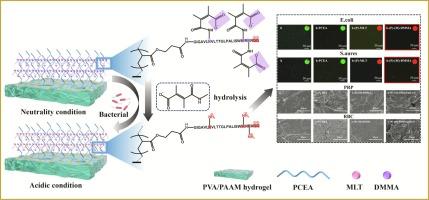基于抗菌肽的 pH 响应型聚乙烯醇水凝胶人工血管移植物具有优异的抗菌性和血液相容性
IF 5.8
2区 化学
Q1 POLYMER SCIENCE
引用次数: 0
摘要
血栓形成和感染是限制小直径人造血管临床应用的主要挑战。大量研究都集中在改善人造血管材料的血液相容性,解决抗凝活性、抗血栓形成、低溶血率和减少血小板粘附等特性。然而,人们对这些材料的抗菌性能关注相对较少。本研究利用聚酯编织管和 PVA/PAAm 水凝胶材料,结合表面改性技术,开发出一种 pH 值响应型抗菌水凝胶人工血管移植材料。水凝胶表面接枝了聚合物刷分层结构,并固定了抗菌肽 MLT 以赋予其抗菌特性。此外,还共价连接了 2,3-二甲基马来酸酐(DMMA)作为屏蔽基团,以实现环境响应策略。研究表明,这种人造血管移植物具有结构稳定性、优异的机械性能以及良好的细胞和血液相容性。此外,它还具有 pH 值响应能力,能在低 pH 值环境中激发高效的抗菌活性。改性抗菌水凝胶人工血管材料溶血率低、抗凝血性能优异、血小板粘附性降低。因此,将 MLT 与 DMMA 结合的策略可有效提高人造血管材料的血液相容性和响应性抗菌性能。本文章由计算机程序翻译,如有差异,请以英文原文为准。

Antimicrobial peptide-based pH-responsive Polyvinyl alcohol hydrogel artificial vascular grafts with excellent antimicrobial and hematologic compatibility
Thrombosis and infection are the primary challenges limiting the clinical application of small-diameter artificial blood vessels. Numerous studies have focused on improving the hemocompatibility of artificial vascular materials, addressing properties such as anticoagulant activity, antithrombogenicity, low hemolysis rates, and reduced platelet adhesion. However, there has been comparatively less attention given to the antibacterial properties of these materials. This study utilizes polyester braided tubes and PVA/PAAm hydrogel materials, combined with surface modification techniques, to develop a pH-responsive antibacterial hydrogel artificial blood vessel graft. The hydrogel surface was grafted with a polymer brush hierarchical structure, and antimicrobial peptide MLT was immobilized to confer antibacterial properties. Additionally, 2,3-dimethylmaleic anhydride (DMMA) was covalently attached as a shielding group to achieve an environment-responsive strategy. The research demonstrates that this artificial blood vessel graft exhibits structural stability, excellent mechanical properties, and good cellular and hemocompatibility. Furthermore, it exhibits pH-responsive capabilities, triggering efficient antibacterial activity in low pH environments. The modified antibacterial hydrogel artificial blood vessel material shows low hemolysis rates, excellent anticoagulant properties, and reduced platelet adhesion. Therefore, the strategy of combining MLT with DMMA may effectively enhance the hemocompatibility and responsive antibacterial performance of artificial blood vessel materials.
求助全文
通过发布文献求助,成功后即可免费获取论文全文。
去求助
来源期刊

European Polymer Journal
化学-高分子科学
CiteScore
9.90
自引率
10.00%
发文量
691
审稿时长
23 days
期刊介绍:
European Polymer Journal is dedicated to publishing work on fundamental and applied polymer chemistry and macromolecular materials. The journal covers all aspects of polymer synthesis, including polymerization mechanisms and chemical functional transformations, with a focus on novel polymers and the relationships between molecular structure and polymer properties. In addition, we welcome submissions on bio-based or renewable polymers, stimuli-responsive systems and polymer bio-hybrids. European Polymer Journal also publishes research on the biomedical application of polymers, including drug delivery and regenerative medicine. The main scope is covered but not limited to the following core research areas:
Polymer synthesis and functionalization
• Novel synthetic routes for polymerization, functional modification, controlled/living polymerization and precision polymers.
Stimuli-responsive polymers
• Including shape memory and self-healing polymers.
Supramolecular polymers and self-assembly
• Molecular recognition and higher order polymer structures.
Renewable and sustainable polymers
• Bio-based, biodegradable and anti-microbial polymers and polymeric bio-nanocomposites.
Polymers at interfaces and surfaces
• Chemistry and engineering of surfaces with biological relevance, including patterning, antifouling polymers and polymers for membrane applications.
Biomedical applications and nanomedicine
• Polymers for regenerative medicine, drug delivery molecular release and gene therapy
The scope of European Polymer Journal no longer includes Polymer Physics.
 求助内容:
求助内容: 应助结果提醒方式:
应助结果提醒方式:


